Chapter Twenty-Four
At Home on Kauai
Master named the lush seven-acre property Sivashram and made it his home, a courageous move in those days, leaving all past history and properties, moving thousands of miles away to a new land, a small island. Thus ended a long search for his spiritual headquarters. §
Years ago, we came to Kauai and finally never left. I chose Kauai, the world’s most remote land mass, because I wanted to be close to my devotees in the East and close to my devotees in the West, while at the same time cloistered from the world at large. Yes, our inner life is more important than our outer life. If we were in San Francisco, New York, Singapore or New Delhi, we could not do this same work as a contemplative order of meditators and teachers, outreaching primarily through publications and the Internet. Kauai is a spiritual place, a vortex of healing energies emanating from its sacred Mount Waialeale, pristine air and ocean.§
To keep in close touch with the careful planning needed to prepare for the upcoming Innersearch programs, he installed a teletype system between all three centers—Virginia City, San Francisco and Kauai. These large, metal typing stations brought great clarity to the pilgrimage planning and made communications across the sea and an overview of the many activities of the Church a much simpler matter. It was the email of its day, and could also serve as instant messaging if two or more were online together. §
Master, whose Shum name was Mamade (pronounced “ma´-ma-dee”), also sometimes called Madereh (meaning “satguru”), would sit and type long messages (only upper case was available) offline, onto a paper ticker-tape. Hundreds of feet of the tape, perforated with millions of tiny round holes, filled several forty-gallon plastic barrels. These were later fed back into the machine to transmit at 300 baud for hours, when the phone rates were low, to his monasteries, where they emerged from the machine on tractor-feed paper. Here is one of those messages to his monks, full of esoteric instruction in the Shum language for them to work on toward their goal of Self Realization.§
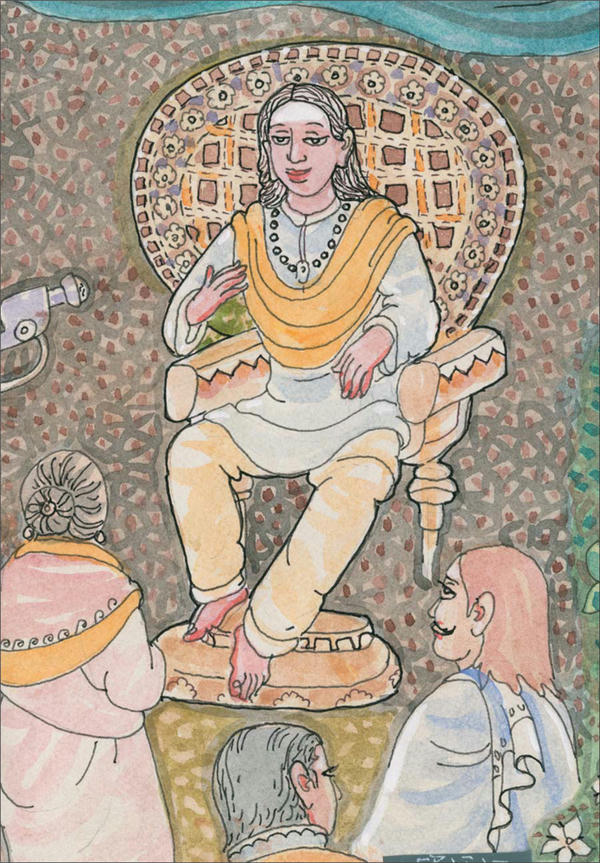
For weeks in 1970 Master sat in a wicker chair at his tropical Kauai monastery, spontaneously dictating twelve hours of mystical upadeshas that would become an audio edition of his primary teaching vehicle, The Master Course.
• • • • • • • • • • • • • • • • • • • • • • • •§
MESSAGE TO THE NATYA AT THE TEMPLE
SEPTEMBER 6, 1970
FROM MADEREH§
I ARRIVED SAFELY IN LIHUE (THAT MEANS GOOSE PIMPLES IN THE HAWAIIAN LANGUAGE) SAFE AND SHUMSIKA ABOUT ONE OCLOCK OUR TIME YESTERDAY. IT WAS A LOVELY TRIP ON A 747 FROM SAN FRANCISCO. WE HAD A FINE SPIRITUAL TIME TOGETHER. THE MEMORIES STILL LINGER. MERCI.§
GOOD TO BEGIN PLANNING FOR THE BUSINESS MEETING FOR THE FAMILIES ON THE FIFTEENTH. TODAY THERE WILL BE MANY THINGS TO DISCUSS ABOUT THE NEXT LUAU, ETC., ETC., ETC. BOTH THE BUSINESS MEETING AND THE LUAU WILL BE HELD AT THE TEMPLE FROM NOW ON, SO WE CAN PLAN FOR THAT NOW. §
BEST WISHES AND BLESSINGS FOR A WONDERFUL WEEK. WORK HARD ON MOOLINGSHUM. EACH MAKE SOME SENTENCE SKETCHES TO SEND ME SO THAT I CAN LEARN IT ALONG WITH YOU, PLEASE.§
IT IS BEAUTIFUL HERE TODAY. THE SUN IS SHINING. THE RIVER IT IS FULL, REMINDING ME OF THE ABUNDANCE THE FAMILIES WILL HAVE ON ALL PLANES IN THEIR FUTURE LIFE.§
SHUMSIKA BIMAOO BASENAM SHUMMALE§
STRIVE FOR EEKAEF OO EMKAEF. KEEP YOUR GOAL EVER IN THE MEMORY CELLS OF YOUR IMMEDIATE DAILY AFFAIRS. KAEEF OO EEKAEEF OO EMKAEEF.§
LOVE, YOUR MAMADE§
Globe-Trotting Guru
Though the transition from Nevada to Hawaii was all-consuming, Master continued the travel-study programs, taking 25 students to Switzerland in July and August, and 29 more to Tahiti and Ceylon during the month of November. This second visit to Jaffna deepened the ties with his Saiva roots and with Yogaswami’s devotees, and those who traveled with him were immersed in Saivite temple worship and festivals. While in Colombo, he accepted an invitation from the Buddhist Meditation Center, where he spoke to over 700 Buddhists, partially in the Shum language and partially in English, the whole being translated into Sinhalese. §
The year’s third pilgrimage, a nine-day retreat held in December, included Kauai and the islands of Hawaii, Maui and Oahu. During the days at Sivashram on Kauai, he gathered the seekers each day in the Hibiscus Room. In his pure white outfit he sat in a large, elaborately woven wicker chair, recording hours of inspired talks that were later compiled, printed and packaged by his monks in Nevada into the sixth edition of The Master Course, twelve one-hour lessons on cassette tape that became his primary teaching instrument for many years. §
While settling into his island home, Master continued to travel extensively, monthly to his other two monasteries and almost weekly to Honolulu to hold meditations and give public classes. A major renovation plan for the old inn evolved, and soon a group of followers flew to Kauai to undertake intensive remodeling of the 1929-vintage estate. For some three years the whining of saws and pounding of hammers became familiar sounds. He gave the new rooms exotic names: the Palace of the Noonday Sun, the Ryokan, Peacock Court and the Hibiscus Room. It was a heady time, full of travel, of new and constant publications and the establishment of his home. He always saw it as the guru’s home, not an institution. §
The monks planted tropical gardens and imported Toggenburg goats, the first in the state, for milk. Master bought horses and had the young monks learn to train and care for these intelligent creatures, advancing to equestrian jumping and barrel running. The virgin monks were commissioned to hire stallions for the mares and witness the breeding ritual and the birth, to enhance their understanding of nature’s ways. Similarly, Gurudeva brought cows into the monastery to provide a touch of nature and, not insignificantly, milk and all of its gifts. §
During the 1972 India Odyssey, 75 seekers traveled around the world with Master through Hawaii, Japan, Thailand, Sri Lanka (which became a republic and changed its name from Ceylon that year), India, Iran, Russia and France. More than before, he immersed them in the mysteries of Saivite temple worship and, as was his way when traveling, he took them to meet the spiritual lights of each nation they visited, Indian saints and yogis, the Dalai Lama in Dharamshala, Buddhist lamas in Nepal, Russian Orthodox priests in Moscow, Zen masters in Japan and imams in Iran. §
Amid these serious visits, Master showed his easy humor. During the bus ride to Dharamshala to see the Dalai Lama, he led the Innersearchers in a long and rousing rendition of “Hello, Dolly!” After spending a day in Ganeshpuri with Swami Muktananda, he was on the bus returning to Bombay when a pilgrim inquired if he regarded the renowned swami to be enlightened. The philosophical exchanges at the ashram that day had been made through an unusually adept translator, Professor Jinendra Jain. Master thought for a moment, then offered, “Well, either he is or his translator is.” Everyone on the bus roared. §
In Paris, he met Swami Bua, a humor-loving yogi who would later visit Master’s monastery often and live to be 120 by one calculation. There were remarkable encounters with Ananadamayi Ma, the senior Shankaracharya from Kanchipuram Matha, Maharishi Mahesh Yogi, Indira Gandhi, a saint named Pundiswami (since he lived in the village of Pundi), who never moved or stood and whose legs had completely atrophied, and others. §
All across Tamil Nadu, Master visited the ancient Saiva aadheenams, eager to observe and absorb how these temple-monastery complexes operate, how they are organized, funded and administrated, the subtleties of how the gurus dress, talk, worship, live, their protocols for interacting with guests and junior swamis, their relationship with the surrounding community, the traditional ways in which devotees serve—to take it all back home to Kauai to continue building an authentic Saiva aadheenam of his own in the West. §
These experiences would fructify over the ensuing two decades as he brought the sacred symbols of the spiritual office with him: the shirobhashanam (crown of rudraksha beads), the silver danda (staff), the simhasanam or “lion’s seat” upon which the aadheenakarthar (pontiff) sits, the unique kundala (golden earrings) and the golden pendant he wears. He would bring all these Saiva insignia to Kauai, to the West. §
One day in New Delhi he took an early walk during a quiet day. It proved to be a momentous one. He later described it:§
Having pilgrimaged with seventy-five monastics and devotees throughout India and Sri Lanka to saints and sages, ancient temples, dharmashalas, aadheenams and modern ashrams, I happened late one morning, during a spontaneous walk, upon an extraordinary Lord Siva Nataraja Deity at Nirmala’s Copper Bazaar. I walked around the wondrous six-foot-tall bronze statue situated on the busy sidewalk and quietly said, “Hello!” It was the store’s insignia and showpiece, too precious to sell, the owner declared, as no value could be attached. Bravely disregarding that fact, we bargained and traded through the morning hours and ultimately acquired it, and as evening approached arranged for its shipment to our distant Garden Island of Kauai. §
At Mahasivaratri time a year later, in 1973, in the jungles of Kauai, our Kadavul Nataraja Deity, Lord of the Dance, arrived at Sivashram and was placed in the gardens overlooking the sacred Wailua River, where it was spontaneously decorated, bathed and worshiped. That night the exact location of the Deity’s installation was chosen by Lord Murugan Himself when He appeared to me in an early-morning vision, upturned His glistening vel, His scepter of spiritual discernment, and powerfully pounded its point three times on the cement steps at the monastery entrance, marking the precise spot to place the Deity. §
Lord Murugan’s orders were obeyed. On March 12, the Deity was moved into place and worship began immediately. A rotating 24-hour vigil was established, and it has been maintained without a single hour’s lapse to this very day. Under this strict monastery discipline, monks take turns every three hours in the temple, night and day, 365 days a year. During this vigil, they perform constant meditation, puja, yogas and chanting, quelling the mind and giving themselves in profound adoration, prapatti, to this remarkable icon. Thus the arrival of the Siva Nataraja Deity transformed our life, and from that day onward life in and around the monastery has revolved around His divine presence. §
This establishment of Kadavul Hindu Temple on the lush, tropical Garden Island of Kauai, Earth’s most remote land mass, at the base of Hawaii’s oldest extinct volcano, known as Mount Waialeale, eventually was recorded in the State archives by the Governor as the first Hindu temple in Hawaii. §
With the arrival of Lord Nataraja, thousands upon thousands of devas of the Second World and devas and Mahadevas of the Third World penetrated the inner atmosphere of the Lemurian mountaintop island of Kauai from several ancient temples—in Sri Lanka, the precious Kumbhalavalai Koyil, mystic Nallur and potent seaside Tiruketeeswaram, and in India, the mighty Chidambaram, Thanjavur’s Brihadeeswarar, which I am said to have built in a previous life as Rajaraja Chola, according to several jyotisha nadishastris, and the sin-dissolving Rameswaram, overflowing in healing waters in twenty-two wells. The three worlds had at that moment become connected as one, and the Saivite Hindu religion began to flourish on this side of the planet. §
Master had another vision of Lord Murugan, known in North India as Karttikeya, around the same time. One early morning in his small chalet next to the Tiruvadi Monastery in San Francisco, adjacent to the temple on Sacramento Street, Master had a vision that brought Lord Murugan even further to the forefront of his order’s life. Suddenly, he found himself flying with a handsome, muscular being around the monastery room. Master later told the monks that he had asked the powerful being who he was, and received the reply, “If you don’t know, who does?” He knew, it was Murugan Himself. §
Master was so inspired by that encounter, he planned to write a book called Flying with Murugan. Though the book never manifested, Murugan’s influence in and on the Order did, and Master always felt the first of all sannyasins, son of Siva, was the tutelary head of his monastic community. Nearly every one of his monks was given a name of Lord Murugan and taught to regard this mighty one as a personal guide and example of purity, detachment, willpower and speed of accomplishment. §
Books from the Inner Worlds
Kadavul Hindu Temple became the center of the monks’ lives, and they began years of training in the devotional arts of Sanskrit chanting and puja. The Gods were introduced to them by Master, and they learned to make them the center of life, their support and their friends. §
Slowly, methodically, Master was, in a big way, bringing everything of the tradition to the West, every monastic ideal, every temple protocol, every yogic practice, planting them all in the fertile Hawaiian soil. §
Each day he drove, with one or two monks, the five miles to the post office, as in those early days there was no mail delivery to the rural areas. Taking the day’s correspondence to a table at the Coco Palms Hotel, he would order a cup of coffee and, opening each letter, dictate his responses, which the monks would type up and mail later that day. §
On one such day, something remarkable happened. It had never happened before. It would last for months, and it would never happen again. Here is Master’s description of that morning:§
Soon after we had placed the Nataraja Deity, my inner eye, within the ajna chakra, was opened upon an array of great manuscripts, and the inner library of Lord Subramaniam was seen. Upon each wish and fancy, the librarian—a tall, fine, elegantly robed, bearded man—would pull forth from one shelf or another great volumes and with firm hands open and turn the pages to the proper place to be read. I read these volumes one after another to the monastics at Sivashram after this siddhi was obtained. They asked questions. The books were placed within the inner ether of my mind, the pages turned and read and enjoyed and understood. Thus, Siva’s great diamond-dust-like darshan flooding out opened the inner door of our Lord Subramaniam’s private library, which contains the records accrued since His arrival on this planet. Lord Subramaniam, the South Indian God also known as Karttikeya, Murugan, Skanda and Sanatkumara, has always been near and dear to us. §
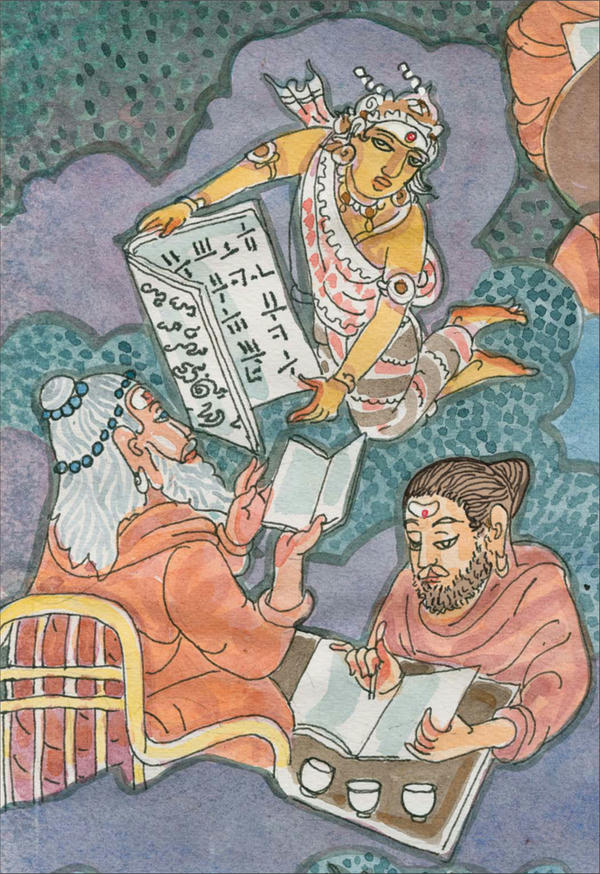
While having morning coffee at Coco Palms Hotel, Master suddenly encountered an astral plane librarian holding a large book with strange scripts. He knew the meaning as his inner eye scanned each page. In the months following, he dictated an entire book to his monks.
• • • • • • • • • • • • • • • • • • • • • • • •§
The venue of this remarkable clairvoyant happening was the garden restaurant of Coco Palms Hotel. As the librarian presented each volume and turned page after page, I dictated slowly to a sincere monastic scribe, who patiently and accurately wrote down each word. These were the days when cigarette smoke billowed forth from elite hotel guests at neighboring tables, clouding the atmosphere and creating an ambiance in which the akashic manuscripts could be clearly seen. The backdrop of Hawaiian music, the hubbub of people talking and the lower vibration of worldly feelings, too, helped screen out the conscious mind to make this clairvoyant siddhi a working reality. §
On some days reams of pages were turned and read; on other days nothing was seen. Vigilantly, morning after morning, week after week, month after month, we sat waiting, while enjoying fruit, yogurt and coffee, for my inner eye to open on the inner-plane library. The restaurant was not in an ordinary location. Our table overlooked tropical ponds amid the island’s largest coconut grove near the ocean on the east side of Kauai, the oldest and northernmost of the Hawaiian archipelago. Each day’s writings, gleaned by my astral vision near the birthstone heiau, where royalty were birthed in olden times, were penned in letter-sized spiral notebooks. Before noon, we returned with them, following the sacred Wailua River four miles inland, to my ashram, now the site of Kadavul Hindu Temple.§
What he returned with each day was a new chapter of the Lemurian and Dravidian Shastras, which was read only by the monks for twenty-four years before Master felt the world was ready and released it under the title Lemurian Scrolls. It was a revelation, a divine transmission that unfolded the early history of mankind in remarkable detail, how we came to this Earth four million years ago, the spiritual culture of early man, the mysteries of the kundalini and the Central Sun—focusing on the nature of life within ancient cloistered Saivite monasteries—how we lived in the ages now lost to human history. §
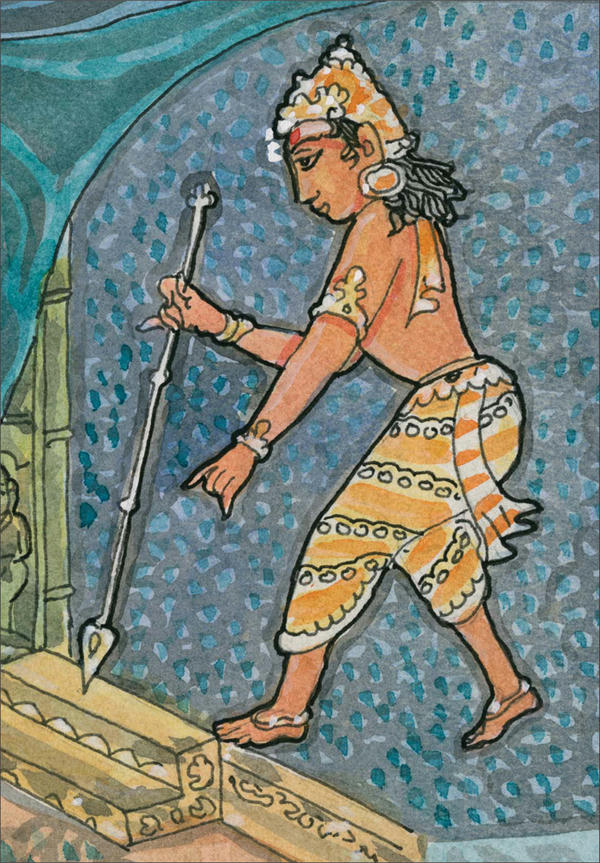
As Master reposed one morning, his third eye opened to see Lord Murugan, who lifted His Vel and struck it powerfully three times on a step, indicating that the six-foot-tall Siva Nataraja that had arrived from India should be placed “here.”
• • • • • • • • • • • • • • • • • • • • • • • •§
Much of what was revealed to Master answered a need for traditional principles to effectively guide and govern his monasteries, provide a traditional pattern of Hindu ascetic life and catalyze his monks’ spiritual unfoldment. These Shastras, along with the Saivite Shastras, an intimate revelation that a group of devas wrote exclusively for Master’s monastic order, became a spiritual guideline that strengthened their faith and informed every dimension of their existence. The monks treasured the privilege and blessing of being around Master as these superconscious revelations poured through him each day, as the wisdom of the ages revealed itself page by page by page; much like being with the rishis of yore, they thought. Gurudeva told of those days:§
The early revelations were enjoyed by mathavasis at Sivashram and shared with others at our branch monasteries via an in-house teletype network, named biniba in Shum, our language of meditation. As the flow continued week after week, mathavasis in San Francisco, California, and in Virginia City, Nevada, gathered ’round to read the spellbinding messages being clacked out on the piano-size communication devices. The monks were able to type questions to me and receive my responses in real time from Hawaii, thousands of miles away. We enjoyed many philosophical discussions in this way. §
As each volume finally drew to completion, it was typed up by the scribe on an electric IBM typewriter, from which a dozen or so copies were made and cased in plain, white, softcover binding. One chapter was read daily at the meditation sessions to mold a new standard of selfless living in my monasteries. §
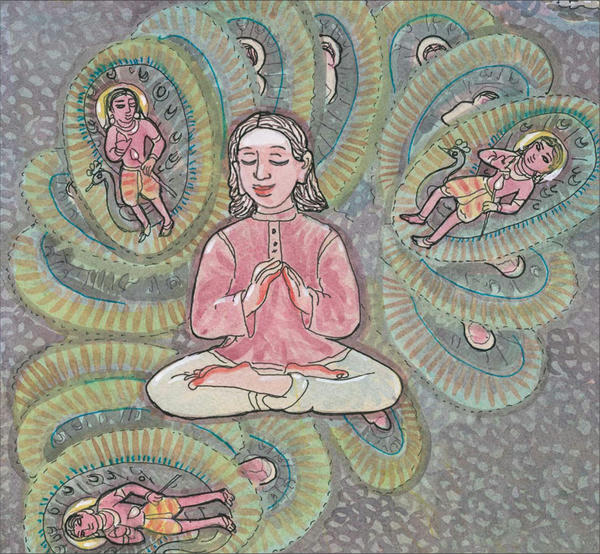
Meditating one morning at his San Francisco monastery, Master Subramuniya suddenly found himself flying around and around the room, with Lord Murugan flying at his side.
• • • • • • • • • • • • • • • • • • • • • • • •§
The devas said in their writings that there were many more books to be read; but once the Saivite Shastras had been completed, Master found it much more difficult to access the library of Lord Subramaniam on the screen of his inner vision. He struggled, in the face of external distractions, to keep this inner world open to him.§
Now we are starting our inner work in 1974 and I don’t see a thing in front of me on the screen. The devas must be off someplace. They are finishing up their work with some of the students and devotees who visited Sivashram on the Ganesha pilgrimage. Now I’m beginning to see the glimmering light in the blue akasha, shimmering gold and silver lights reflecting off each other, dancing around in front of my forehead. This is seen with the third eye and I also see feelings, and entanglements, thoughts that have been blocking the vision due to the new guests and retreatants, who are fading into the distance as the shimmering lights take over. I have been working for three days now to get into this state, which was wide open for many months in 1973 when the shastric books were seen.§
While Master’s mystic explorations never stopped, they changed dramatically at this point. Rather than clairvoyantly reading akashic books, he communicated clairaudiently with three or four great devas to receive their advice and insights on current affairs that concerned him. These messages were vast and varied, from lofty dissertations on temple mysticism to earthy insights into the karmas of the newest monastic candidate.§
Most central were the communications with an overlord who last lived on Earth as an aristocrat 10,000 years ago. When called upon, he provided guidance, especially about the future, pointing out the best direction to be taken and speaking, in transcendental tones, of the importance of the work in which Master was engaged. This rishi’s messages, often the most profound and precious of all, were carefully written in a notebook or scribbled on a napkin in some tea shop in Japan, at a coffee table in Madras or in a cozy corner of Master’s own office at the monastery. §
During a session on Kauai on September 14, 1983, the monastic scribe asked how the devas work with the holy ash prasadam of Kadavul Temple that the monastery sends to devotees in the mail. The rishi responded:§
With prasadam we are there, and with shakti we are there. The prasadam opens a channel, a long-lasting channel, between us at Kadavul and the devotee. The vibhuti especially holds the vibration. You have an open channel between you and certain temples in India. This is because the vibhuti from those temples is at the Aadheenam. Generously fill the homes with vibhuti from Kadavul, and they will draw on the shakti from Kadavul Nataraja and the open channel will remain wide and clear. Try to obtain your vibhuti from a certain place where it is made in the traditional way. The vibhuti is the voice of Kadavul. Give full amounts in your prasadam bags, not just a stingy little bit. And the guru’s vibhuti pouches should be fat and overflowing.§
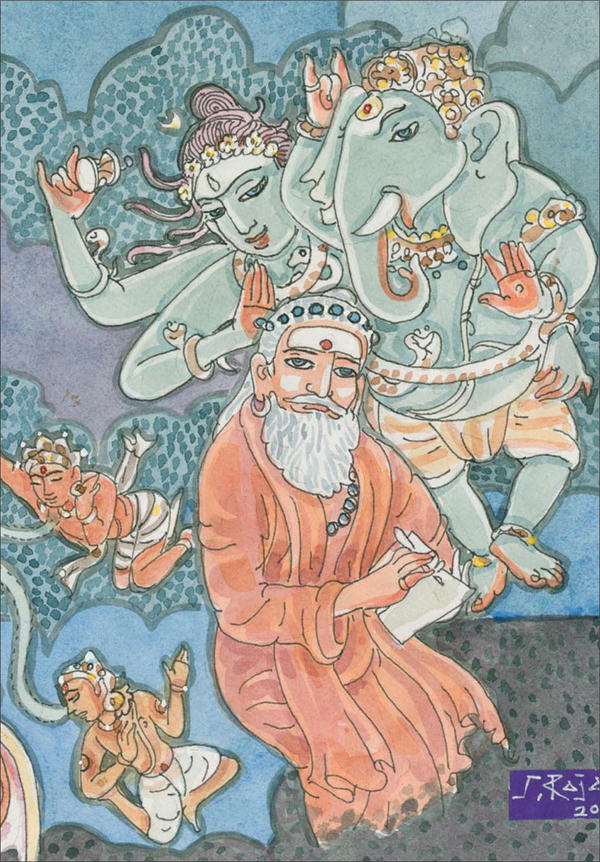
On rare occasions, Gurudeva received messages from the Gods of Saivism, poetic and sometimes cryptic verses from God Siva, Hanuman, Murugan and Ganesha. He dutifully wrote down and followed all such celestial decrees.
• • • • • • • • • • • • • • • • • • • • • • • •§
The knowledge shared by Master’s band of great devas was limited only by the quality and depth of the questions asked. It was not unusual, once a strong connection was made, for the devas to linger for an hour or more, and for Master to ask every now and again, “Any more questions?” The queries focused on current events, issues, people, philosophical queries and problems of the day. Master received invaluable, practical guidance for every aspect of his mission in these sessions, and the monks with him experienced a rare glimpse into another world, a world so familiar to Master, just as real as this world—more, he might say. He explained the way these beings of the inner worlds work to assist sincere aspirants who are incarcerated in physical bodies.§
There are well-trained devas in the astral plane who work very closely to the Earth, seeing to the needs of all devotees worldwide. Devas who headquarter at Kauai Aadheenam’s Kadavul Koyil attend the satsang homa held within the mission houses, dharmashalas and temples and monasteries of our members. This inner network of Mahadevas and devas, swamis, yogis, natyams, sadhakas, brahmacharis, brahmacharinis, mothers, fathers, children, in a divine way all work together. This is Saivism. This is Saiva Siddhanta. This is the Natha Sampradaya in action. This is how it was in the past when Saivism flourished all over this planet. This is how it is today. And this is how it will be in the future.§
Fascinated with Master’s helpers on the other side of the mind, the monks wondered what the rishi they had been hearing from looked like. One day in 1996 Master announced, “Rishi just appeared. I see him sitting there in white robes. He looks very nice. ‘Greetings,’ he said with a wave of his hand. Here is his message:”§
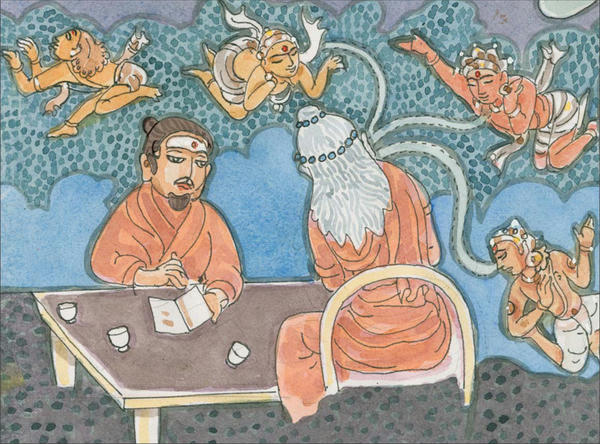
Inner plane devas frequently guided Gurudeva, answering his questions and those of the monks, offering practical counsel and even helping to find lost items. He received their messages clairaudiently or by thought transference.
• • • • • • • • • • • • • • • • • • • • • • • •§
It is time to be concentrated, precise and rigid. We have accumulated much, and more than is needed, knowledge for the future and all time. It has to be edited back, reexplained when necessary, and lived. (Master: “Different ones are lining up [to talk]. Any questions?” Master comments, “He looks a little younger,” and the rishi responds:)§
You are making me young by responding. It is lonely here sometimes in bliss. We have only the fullness of our Self, the company of our perceptions. Those in bliss don’t talk to each other. There is no communication here. What is there to talk about when each of us knows what the others know? So, it is a welcome event to help out the unknowing. (Now he sits back and relaxes as if to say, “What do you want to know?” with a big smile on his face. “What loka are you in?” asks one monk.) In the Brahmaloka. And it is a nice place to be. Very active, harmonious, productive. Here everything that you have and use is conceived. This is the world of conception.§
One of the strongest messages the Shastras brought for the monks was the value, meaning and absolute necessity of strict celibacy, brahmacharya, in monastic life. The devas gave detailed guidelines, including special sadhanas for those who had lived with women. Only those who had not lived too promiscuously could enter the swami order. Gurudeva addressed that theme in his Master Course trilogy, drawing a passage from The Book of Virtue, part of the shastric books he had clairvoyantly read.§
Brahmacharya is holding the power of the Divine within the core of the individual spine so that, as Lord Siva sends His power through the five great winds of the astral body within the physical body, the winds adjust among themselves and emanate a shakti strong enough to adjust the five great psychic fluids within everyone around. This power of brahmacharya is accrued and disseminated through sublimation, then transmutation, of the sexual force. Transmutation occurs automatically through regular daily sadhana, the rigors of positive living and adherence to the ceremonial customs of our religion. Ideally, brahmacharya begins at puberty for virgins and continues on until marriage. Otherwise, brahmacharya sadhana begins after the last sexual encounter with a member of the opposite sex has occurred and when a conscious decision is made to begin the practice of brahmacharya. §
On rare occasions through the decades, Master blessed his monks with insights into their previous births, sitting alone with them for hours as the devas recounted in exquisite detail a series of lives the monk once lived, accomplishments made, and how the monk would contribute to Master’s mission in this current incarnation. One learned of lives as a Chinese printer, an early American leader and an explorer. §
While traveling with a swami on a month-long journey in India in 1982, Master brought through such knowledge one evening in New Delhi. At the dinner table, a deva made contact with Master, identifying himself as the muse of the hotel astrologer, and invited questions. For the next hour, Master unfolded details of three of the monk’s past lives, guiding the session by explaining that the deva required that the monk write down each question he had. Then, standing behind the monk, the deva would read the question and respond, telling of previous lives as a sadhu in India and a merchant in Europe, and of his future in the Order. Master noted that the deva did not speak in words as some devas do, but rather projected his ideas as thought forms. The travelers from Hawaii had passed, several times, the doorway of the astrologer’s office in the hotel, and been inexplicably attracted to the sign on the door. At the end of the evening, Master handed the monk fifty rupees and instructed him to slide the bills under the astrologer’s door as payment for the reading, so that all the karmas of the interchange would be rightly balanced. For Master, it was money well spent.§
These experiences with the devas built strong the faith of the monastics, helping them become strong, dynamic soldiers of the within. The devas themselves gave assurance in their messages that they were there to assist and empower them on the monastic path.§
When a new natyam or sadhaka enters one of our monasteries, his life pattern is perceived, understood and digested. The natyam’s or sadhaka’s karma is absorbed into the total group karma of all the monasteries, missions and individual devotees. Once he has taken his vows, received sandalwood beads, each flower placed upon an altar, every camphor flame and act of religiousness performed by anyone of any mission or monastery any place in the world melts away some of the natyam’s or sadhaka’s karma. This is because of his supreme act of dedicating himself as a servant, a slave, a Sivanadiyar of the great Mahadevas of our Saivite religion. True, there will be things that come up within his personal life to be worked out, but there will be many helping hands from the Sivaloka, the Devaloka, Kauai Aadheenam, Kadavul Koyil, his own monastery in which he lives and from the surrounding mission, to help him through the turmoil.§
One day at the monastery the monks who were growing food in the garden were invited to consult with the “garden devas.” Here is an excerpt: §
We have fun. If you want to work with us, just have fun. If you want to have fun, just work with us. Do surprises; we like that. Hiding an okra seed in a cabbage patch, now that’s fun. And don’t make everything the same, and don’t eat the same food all the time. If all people were the same, that would be no fun. Don’t line us all up the same in every line. Grow things in patches, slip in a few surprises, and we’ll have a ball. As you find many varieties of people, so you find many plants in the garden. §
Now, the lettuce, it doesn’t like to be near the cabbage. Not even close. There’s a whole group of cabbages, the cabbage family, that should all be stuck away in one corner of the garden, far from the lettuce. §
Plant things in the lettuce patch that taste good with lettuce. Radishes and onions and lettuce—like that. Have fun with it, but keep the cabbage away from the lettuce. Lettuce has no taste, so grow what helps it taste good.§
Master did not want the monks to make much of this side of his life—partly because he saw it as normal and unexceptional, the way a great artist takes his virtuosity for granted, and partly because he knew that devotees would focus on all that magical stuff instead of on their own spiritual growth through sadhana to the Self within. So, these little events, the common coin within the walls of his monastery, never were published, never were reported on the website. Each monk had the blessings of his encounters, to be kept sacred and secret.§
Still, Master did openly, though sparingly, share his inner world with his dear monks, knowing it would be a source of inspiration to them, lifting the veil a bit, revealing another realm of human possibility that ordinary pilgrims on the path rarely get to visit. He would say these are the natural faculties of every human being, waiting deep inside to be unfolded. He would say such things are both our natural heritage and a troublesome distraction from the real work of Self Realization, a two-sided sword that can pull us inward if we accept it with tempered enthusiasm or push us farther from our goal if we become enchanted with the supernatural and the occult and take it on the ego. This balance was, for him, essential, for he was immersed in the supernatural from the beginning, and worked hard to not let it define him or his mission.§